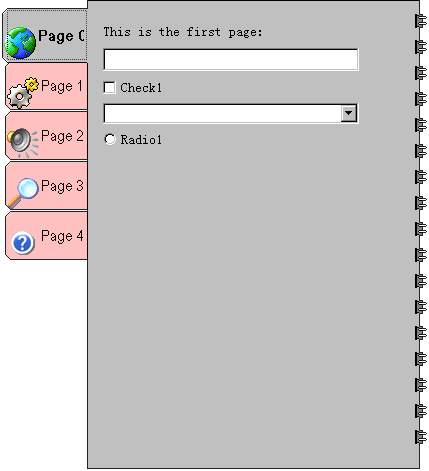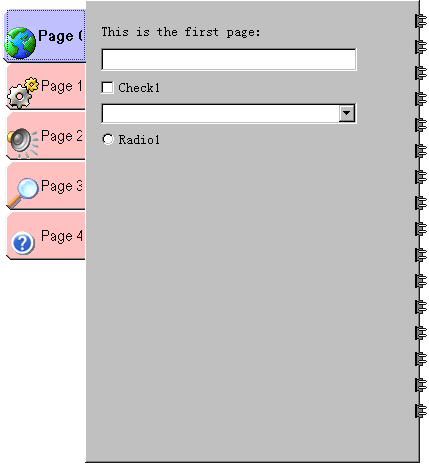|
MFC
Programming: MFC
Tab Control, CTabCtrl
|
| |
|
For MFC
Tab Control, one of the best choice will be use
TFC MFC Library (From ucancode
software), as below:
 and
3d look.

You can
purchase the full source codes of this TFC MFC
Library at here. Below
is also a tab control, that you can use it with your code. CTabCtrlSSL - An easy to use, flexible extended tab control
By Derek Lakin.

Introduction
It's amazing
what a bit of illness can do for your productivity at
home! I've been ill for the last couple of days and here
it is, yet another extended control.
This time my target is the tab control. It seems to me
that the tab control
is a bit out of fashion these days with people preferring
property sheets and pages instead. Well, I tried to use
them and couldn't get the result I wanted. I needed some
controls above the tabbed area (a bit like the demo, but a
few more controls) and I just couldn't get that with
property sheets and pages.
The problem
with the standard tab control is that involves loads of
effort to get pages in to the tab
control. A quick in the MSDN located an example
by Jeff Prosise that implemented a tabbed view, CTabView,
allowing the tabs to be specified as dialog resources.
Well, when it comes to code I'm a bit like I was as a ten
year old with watches: I've got to fiddle about with it
and see how it works and wonder how it could be better.
The first
problem was that Jeff's solution was for a view class and
I needed a control. The transition here is fairly easy as
the view just wraps up the control. The second issue I had
was that it didn't give much flexibility over what you
could do with the tab pages. "How do I handle events
within the page?" I ucancode.neted myself. The answer was to
allow the client to inherit from the tab page class and
allow tab page objects to be added to the control and not
just dialog resources.
Why is that
solutions always present a new problem? By allowing this
approach I then introduced a tricky situation with
releasing the tab pages. Internally the tab control was
creating the tab pages on the heap and maintaining a list
of the pages that had been added. When the control was
destroyed delete
was called on each page in turn. This obviously causes
problems if the pages are created outside of the tab
control and passed in to it. In this case the tab control
would destroy the pages created externally and then the
parent dialog would try and do the same!!
After a
lengthy discussion in the Visual
C++ forum with Tomasz Sowinski we came up with
the answer. The tab control has
a protected function for adding pages to the control and
the public functions call this one. What is actually
passed in to the protected function is a structure
containing a pointer to a tab page and a flag indicating
if the tab control should destroy it. This way if the tab
page is passed in then the flag is set to false, but if
the tab control creates
the tab page the flag is set to true. At destruction time
only the pages with the flag set are destroyed by the tab
control. All others are someone else's problem.
How to use
it
-
Create a
dialog resource and class for the dialog that you want
a tab control on.
-
Add a
tab control from the toolbox to the dialog
resource.
-
Create a
member variable for the tab
control and change it's type to CTabCtrlSSL.
-
In the OnInitDialog
handler for your dialog class create and add any pages
you want on the tab control.
BOOL CCTabCtrlSSL_demoDlg::OnInitDialog () {
CDialog::OnInitDialog ();
int nPageID = 0;
m_tabDemo.AddSSLPage (_T("Basic Tab"), nPageID++, IDD_TAB_BASIC);
m_advancedTab.Create (IDD_TAB_ADVANCED, this);
m_tabDemo.AddSSLPage (_T("Advanced Page"), nPageID++, &m_advancedTab);
m_aboutTab.Create (IDD_TAB_ABOUT, this);
m_tabDemo.AddSSLPage (_T("About"), nPageID++, &m_aboutTab);
return TRUE;
}
As you can
see from the above code sample (taken from the demo), to
add a basic tab call AddSSLPage and just pass
it the resource ID of the dialog resource. For an advanced
tab, create the dialog resource setting the window style
to Child and the border style to none, then call AddSSLPage
and pass in a pointer to your CTabPageSSL-derived
object.
To continue
the style I started with CButtonSSL, here is the
documentation for the classes:
Overview
| Class members | Known
problems
CTabCtrlSSL

A "tab
control" is analogous to the dividers in a
notebook or the labels in a file cabinet. By using a
tab control, an application can define multiple
pages for the same area of a window or dialog box. Each
page consists of a set of information or a group of
controls that the application displays when the user
selects the corresponding tab. CTabCtrlSSL
extends the standard tab control by providing an interface
for adding tabs to the control that are defined as dialog
resources. These tabs are defined internally as CTabPageSSL
objects. There is also an interface for adding objects of
this type to the tab control
allowing custom objects to be defined by inheriting from CTabPageSSL.
Any tab
pages that are created by CTabCtrlSSL (those
where the tab is added by passing in a dialog resource id)
are destroyed by CTabCtrlSSL. It is the
clients responsibility to destroy any CTabPageSSL-derived
objects that are passed in to CTabCtrlSSL.
#include
"TabCtrlSSL.h"
Overview
| Class members | Known
problems
Construction
Page
functions
Overridables
|
OnInitPage
|
Override
in derived class to initialize pages.
|
|
OnActivatePage
|
Override
in derived class to respond to page activations.
|
|
OnDeactivatePage
|
Override
in derived class to respond to page deactivations.
|
|
OnDestroyPage
|
Override
in derived class to free resources.
|
Overview
| Class members | Known
problems
CTabCtrlSSL::CTabCtrlSSL
CTabCtrlSSL
();
Remarks
Constructs a
CTabCtrlSSL object.
Overview
| Class members | Known
problems
CTabCtrlSSL::AddSSLPage
int
AddSSLPage (LPCTSTR pszTitle, int
nPageID, int nTemplateID);
int
AddSSLPage (LPCTSTR pszTitle, int
nPageID, LPCTSTR pszTemplateName);
int
AddSSLPage (LPCTSTR pszTitle, int
nPageID, CTabPageSSL* pTabPage);
Return
Value
Zero-based
index of the new tab if successful; otherwise –1.
Parameters
pszTitle
Address of a
null-terminated string that contains the tab text.
nPageID
The
zero-based numeric ID for referring to the page to be
added.
nTemplateID
Specifies
the tab page’s resource ID.
pszTemplateName
Points to a
null-terminated string that contains the name of the
dialog resource to load.
pTabPage
Points to
the CTabPageSSL object to be added.
Remarks
Call this
function to insert a new tab in an existing tab control.
Overview
| Class members | Known
problems
See Also
CTabCtrlSSL::RemoveSSLPage, CTabCtrlSSL::GetSSLPage
CTabCtrlSSL::RemoveSSLPage
BOOL
RemoveSSLPage (int nIndex);
Return
Value
Nonzero if
successful; otherwise 0.
Parameters
nIndex
Zero-based
value of the item to delete.
Remarks
Call this
function to remove the specified item from a tab control.
Overview
| Class members | Known
problems
See Also
CTabCtrlSSL::AddSSLPage, CTabCtrlSSL::GetSSLPage
CTabCtrlSSL::GetSSLPageCount
int
GetSSLPageCount ();
Return
Value
Number of
items in the tab control.
Remarks
Call this
function to retrieve the number of tabs in the tab
control.
Overview
| Class members | Known
problems
CTabCtrlSSL::GetSSLPageTitle
BOOL
GetSSLPageTitle (int
nIndex, CString& strTitle);
Return
Value
Nonzero if
successful; otherwise 0.
Parameters
nIndex
Zero-based
value of the relevant tab page.
strTitle
A CString
reference to receive the title of the tab page.
Remarks
Call this
function to retrieve the title of the specified item in a
tab control.
Overview
| Class members | Known
problems
See Also
CTabCtrlSSL::SetSSLPageTitle
CTabCtrlSSL::SetSSLPageTitle
BOOL
SetSSLPageTitle (int
nIndex, LPCTSTR pszTitle);
Return
Value
Nonzero if
successful; otherwise 0.
Parameters
nIndex
Zero-based value of the relevant tab page.
pszTitle
Points to a
null-terminated string that contains the title to set for
the specified tab page.
Remarks
Call this
function to set the title of the specified item in a tab
control.
Overview
| Class members | Known
problems
See Also
CTabCtrlSSL::GetSSLPageTitle
CTabCtrlSSL::GetSSLPageID
int
GetSSLPageID (int nIndex);
Return
Value
Zero-based
page identifier if successful; otherwise -1.
Parameters
nIndex
Zero-based
index of the relevant tab page.
Remarks
Call this
function to retrieve the page identifier as specified when
the tab was added of the specified item in a tab control.
The page identifier may also be altered with the SetSSLPageID
function.
Overview
| Class members | Known
problems
See Also
CTabCtrlSSL::SetSSLPageID
CTabCtrlSSL::SetSSLPageID
int
SetSSLPageID (int nIndex,
int nPageID);
Return
Value
The previous
zero-based page identifier if successful; otherwise -1.
Parameters
nIndex
Zero-based
index of the relevant tab page.
nPageID
The new
zero-based page identifier to be set.
Remarks
Call this
function to alter the page identifier for a specified tab
page.
Overview
| Class members | Known
problems
See Also
CTabCtrlSSL::GetSSLPageID
CTabCtrlSSL::ActivateSSLPage
BOOL
ActivateSSLPage (int
nIndex);
Return
Value
Nonzero if
successful; otherwise 0.
Parameters
nIndex
Zero-based
index of the tab page to activate.
Remarks
Call this
function to change the active tab.
Overview
| Class members | Known
problems
See Also
CTabCtrlSSL::GetSSLActivePage
CTabCtrlSSL::GetSSLActivePage
int
GetSSLACtivePage ();
Return
Value
Zero-based
index of the selected tab if successful or –1 if no tab
is selected.
Remarks
Call this
function to retrieve the currently selected tab in a tab
control.
See Also
CTabCtrlSSL::ActivateSSLPage
Overview
| Class members | Known
problems
CTabCtrlSSL::GetSSLPage
CWnd*
GetSSLPage (int nIndex);
Return
Value
A pointer to
the requested tab page if successful; otherwise NULL.
Parameters
nIndex
Zero-based
index of the tab page to get.
Remarks
Call this
function to get a specific tab in the tab control.
Overview
| Class members | Known
problems
CTabCtrlSSL::GetSSLPageIndex
int
GetSSLPageIndex (int
nPageID);
Return
Value
Zero-based
index of the specified tab if successful; otherwise -1.
Parameters
nPageID
Zero-based
page identifier of the relevant tab page.
Remarks
Call this
function to retrieve the zero-based index of a tab page in
the tab control.
Overview
| Class members | Known
problems
CTabCtrlSSL::OnInitPage
BOOL
OnInitPage (int nIndex, int
nPageID);
Return
Value
Nonzero if
successful; otherwise 0.
Parameters
nIndex
Zero-based
index of the tab page being initialized.
nPageID
Zero-based
page identifier of the page being initialized.
Remarks
Override in
derived class to initialize pages.
Overview
| Class members | Known
problems
CTabCtrlSSL::OnActivatePage
void
OnActivatePage (int
nIndex, int nPageID);
Parameters
nIndex
Zero-based
index of the tab page being activated.
nPageID
Zero-based
page identifier of the page being activated.
Remarks
Override in
derived class to respond to page activations.
Overview
| Class members | Known
problems
CTabCtrlSSL::OnDeactivatePage
void
OnDeactivatePage (int
nIndex, int nPageID);
Parameters
nIndex
Zero-based
index of the tab page being activated.
nPageID
Zero-based
page identifier of the page being activated.
Remarks
Override in
derived class to respond to page deactivations.
Overview
| Class members | Known
problems
CTabCtrlSSL::OnDestroyPage
void
OnDestroyPage (int nIndex,
int nPageID);
Parameters
nIndex
Zero-based
index of the tab page being activated.
nPageID
Zero-based
page identifier of the page being activated.
|






